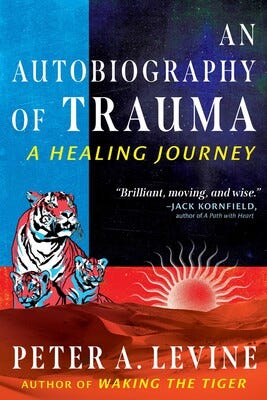I just finished reading Dr. Peter Levine’s newest book, An Autobiography of Trauma: A Healing Journey.
Admittedly, I was skeptical and even irritated that another old, white dude was being heralded as “one of the greatest leaders,” or “one of the seminal trauma pioneers and master healers” of our time. My curiosity overrode my judgement (as it usually does, thank goodness), and I got to hear him present at this year’s Somatic Healing Conference in San Diego.
First, his demo with a participant in the crowd displayed masterful facilitation. His gentle and skillful awareness of himself and the other was inspiring to witness. Then, he shared vulnerable and tenderly about his autobiography, including a dream that guided him to publish it, even though he intended to keep it private. The casual and normalizing tone he spoke about something “irrational” and “nonlinear” really gripped my attention.
I mean, he holds two doctorates, one in medical and biological physics and the other in psychology, surely he must be another typical overeducated white-male ivory tower guarding science-nerd captivated by all things brainy…
OK, I was so wrong. And I am humbled and delighted to be so wrong about a white dude (the more white dudes that prove me wrong the more relieved and hopeful I am 😅).
Dr. Levine’s autobiography pays tribute to the powerful women who helped him to re-member his brain with the rest of his body (Chapter 9: The Four Most Important Women in My Life and Chapter 11: Reflections of an Unsuspecting Prophet), lifts up the earth-wisdom and spirituality of Indigenous leaders and tribes (Chapter 2: Healing with Science and Shamanism), and dreams.
Chapter 3 is titled, Dreams Show the Way. He recounts two dreams that guided him to understanding his purpose and how he was to go about it, resulting in the world renown method he developed, Somatic Experiencing (SE).
On page 47 he writes:
In order to keep SE safe, as in my dreams, I have been impelled to focus in the scientific and clinical components of SE and have not openly addressed its intrinsic spiritual dimensions. Yet in addition to the appreciation of the role of body sensations in healing traumas, I have also come to realize that out of body sensations arises a universe mysterious and transcendent states, perhaps what Carl G. Jung called the mysterious tremendum-that great mystery of life itself.
Dr. Levine models the gifts of balancing linear and nonlinear thinking, thus re-membering one’s wholeness, as described in the book about his personal journey of somatic healing and profound insights revealed from dreams and other non-linear experiences, such as Shamanic journeys and Indigenous rituals.
He also details his triumphs through linear thinking that has helped to capture the attention of scholars, scientists, and clinicians, to name a few, who might have otherwise dismissed his work developing SE, which today has evolved and expanded globally.
The trap of the colonial mindset is binary thinking, one that assumes this way of thinking/doing/being is right and all else is wrong. When we can make space for it all while having the discernment and wisdom of integrating and working skillfully with them, we are healing the parts of ourselves we have betrayed, exiled, abandoned, or forgotten - welcoming all of who we are. The dancing with the both-and and the alchemy of the in-between is where transformation occurs.
To be linear mindset or not to be linear mindset is the wrong question.
How do we make space for both linear and nonlinear thinking to be valued and integrated for holistic wisdom? That is the question.
Dear reader-dreamer, how would you answer this question? Feel free to share any thoughts, including new questions, that are emerging as you ponder this with us.





Wow, I love this so much. Thank you for sharing these rich reflections around the book, dear Minna!